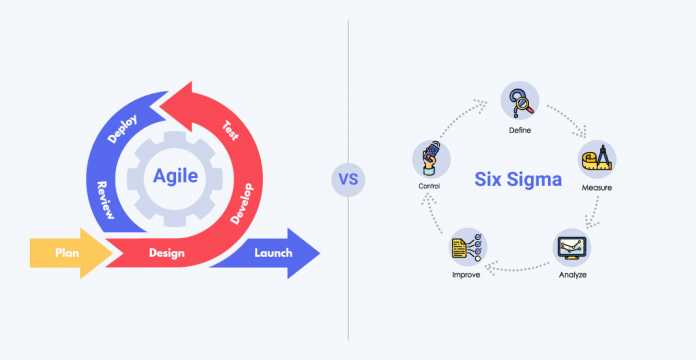
In the present competitive space, there are two main approaches used by companies to develop products, find errors, and improve overall management quality. The two techniques are Agile and Six Sigma. Six Sigma is a methodology that provides many tools and methods to enhance the overall quality of the product. The product quality increases, which helps then cut down costs on manufacturing.
On the other hand, Agile is more focused on project delivery, which leans more on the iterative method of working. Scrum and Programming are the core parts of Agile methodologies. Some parts of the company integrate Agile into their system for three reasons. The first one is that it can manage the priorities of the project, which saves time and increases productivity.
Second, the teams of Agile are more product-focused because they usually tend to bring the customers into their processes. The last one is project visibility; it has more scope and reaches as compared to other methodologies.
Basic Concepts and Methodologies of Six Sigma
Six Sigma generates profits for organizations by identifying and reducing waste. Now, the waste or defects are identified and solved by using two main methodologies that are like pillars of Six Sigma. They are DMAIC and DMADV models. Both these concepts involve three similar phases- they are Define, Measure, and Analyze. The design and Improve phases are the unique stages in both models.
The tools of Six Sigma mainly focus on customer requirements. They define the quality before addressing defects in manufacturing. All the data sets are gathered by interviewing various groups in society. With data in hand, the Six Sigma teams use Measurement System Analysis to eliminate any errors in the collection.
Involving people and being thorough is the number one thing that is highlighted in every team meeting. Such principles are flexible in any management. The efficiency and morale of workers develop with Six Sigma. The overall work environment shifts to a better spot with the proper execution of Six Sigma concepts.
Basic Concept of Agile
The basic concepts of Agile revolve around project planning and execution. They teach the members to adapt to the situation instantaneously and help them figure out the plan, scope, and design throughout the project. Another concept that is a must is working on software implementation.
Agile doesn’t encourage traditional documentation because it kills a lot of time. The third is collaboration over negotiation. Agile development believes that customers have a stronger bond with the company than any high-value contracts. The final attribute is to adapt to change rather than sticking to the same plan throughout the project.
It helps to develop decision-making skills and improves one’s critical thinking.
Enrolling in Invensis Learning’s Agile Certification Courses & shape your success in the domain!
What are the Major Differences Between Agile and Six Sigma?
Both Agile and Six Sigma focus on customer fulfillment, flexibility, and bringing economic approaches to take the business to the next level. The difference lies in the mechanisms and outcomes they bring to the table. Six Sigma professionals always aim to maximize profits by reducing the variables.
Still, in the case of Agile, they adopt other management approaches that work in the presence of those same variables. Six Sigma practitioners won’t dedicate more time to innovation on the economic front, and they dwell in those same uncertainties. On the other hand, Agile accepts changes and other unpredictable aspects of business and moves forward to the next problem or module.
One other main difference lies in its variations. Six Sigma is designed in such a way that it can only handle operational processes of business management. So, the change is very less in Six Sigma. Coming to Agile, handles multiple parameters in its software development methods. The numbers and patterns are more detailed in Six Sigma when compared to Agile. This way, the management can come up with more intuitions and relationships with its customers.
The same is not possible with Agile. Cultural differences also exist between the two programs. Six Sigma believes that iterations and modifications are best executed with the help of only experts or professionals. Agile is in no way similar to that cultural values.
Can Agile and Six Sigma Co-exist?
Agile and Six Sigma can point in different directions, but in some scenarios and circumstances, they tend to co-exist. They can be complementary to one another by filling each other’s gaps. While Agile takes care of the creative and innovative side of the business, Six Sigma can focus on process standardization.
Agile can handle uncertainties, and Six Sigma can look at minimizing process variations. Both of them should run parallel in any process, and there should never be any race or competition between them. If both teams of Six Sigma and Agile can understand the principles of “Systems Thinking, “then they can start to co-exist instead of contradicting each other’s principles. With the combination, organizations can explore many areas for improving their overall efficiency.
It benefits the companies by improving the project’s vision and clearing any confusion for the teams. They are also entitled to create a solid portfolio design that can be used for measuring growth or success.
To Conclude…
Some training programs can be misleading when talking about Agile and Six Sigma methodologies. They mention meaningless negative associations in both courses. Some say that Agile methods are performed in chaotic environments, but in reality, it is an adaptive environment that requires constant change.
At the same time, people misinterpret Six Sigma as a method to only cost-cutting and layoffs. All these are just assumptions and are considered myths in the corporate world. If there is a possibility for both Agile and Six Sigma to exist together, then that opportunity shouldn’t be missed. Assigning them to their respective areas in management is the most effective way of taking advantage of both training programs.
For organizations to get the best of both worlds in Agile and Six Sigma, the workforce has to understand both practices in detail and how they can co-exist together. When individuals and enterprise teams get trained in popular Agile courses and Six Sigma Certifications and Quality Management Courses, they will gain a comprehensive understanding of how both practices can co-exist and benefit the organization.
Some of the popular Agile and Quality Management courses are:














